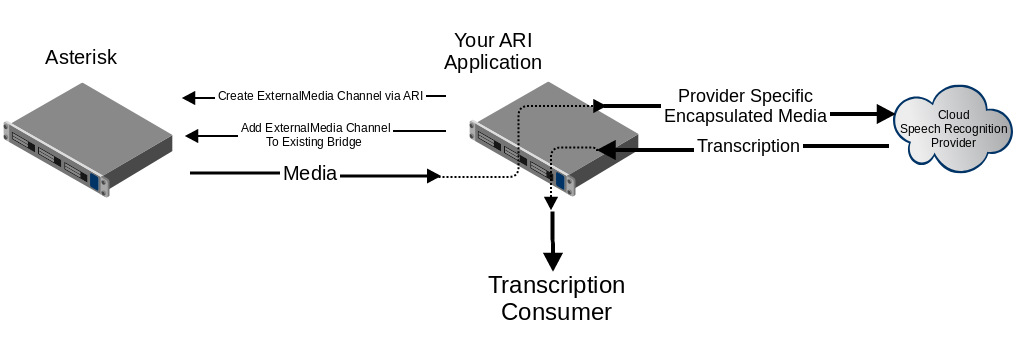Introduction¶
Asterisk 16.6 introduces a new method to allow interaction with an external media server. Using the new "/channels/externalMedia" ARI resource, an application developer can direct media to a proxy service of their own development that in turn can, for instance, forward the media to a cloud speech recognition provider for analysis.
Simple Speech Recognition Scenario:¶

In this scenario, your ARI application creates a new External Media channel supplying some basic parameters like media destination and format, then adds that channel to an existing bridge. The channel driver then forwards all media from the bridge to the destination you specified. Your application takes the media and re-encapsulates it to match the requirements of your chosen speech recognition provider. What you do with the result is up to you. You could store it offline for later retrieval or you could send it to a browser application for real-time display as subtitles, etc.
The External Media channel can also inject media into a bridge it's a member of so you can play progress messages, music, IVR menus, etc.
Implementation¶
To create an External Media channel, you make an ARI POST request to /channels/externalMedia. Asterisk will then return a standard ARI Channel object to you.
Parameters:
| Parameter | Description |
|---|---|
| channelId | (optional) A unique ID to assign to the channel. One will be generated by Asterisk if not supplied. |
| app | (required) The Stasis application. |
| variables | (optional) A JSON object containing any variables you wish added to the channel. |
| external_host | (required) The media destination as <host>:<port>. You can supply an IP address or hostname for host.Be aware though that DNS queries must be done synchronously so the response to the post request may be delayed. |
| encapsulation | (optional) The media encapsulation desired.With the first release of this capability, only rtp is supported as an encapsulation and that is the default if not supplied. Others may be supported in the future.The rtp encapsulation will produce packets with a standard rtp header. |
| transport | (optional) The network transport desired.With the first release of this capability, only UDP is supported and that is the default if not supplied.In the future, it's expected that TCP, TLS and WebSockets will be supported. |
| connection_type | (optional) The connection type (client/server) desired.With the first release of this capability, only client is supported and that is the default if not supplied. In this mode, Asterisk initiates the connection to the external host.When server is supported, Asterisk will return an ip address and port in the response for your application to connect to to receive the media. |
| format | (required) The format/codec you wish the media to be encoded in.Any standard format/codec supported by Asterisk is supported here. For example: ulaw, g722, etc.There is no negotiation. The format you specify is the format you'll get. The channel driver will automatically transcode the bridge's native media into this format. |
| direction | (optional) The media direction (in/out/both) desired.With the first release of this capability, only both is supported and that is the default if not supplied.In this mode, media can flow in both direction on the External Media channel. |
All parameters except variables can be supplied as part of the POST's query string. Because it's a JSON object, variables MUST be supplied on the request body. This is similar to other channel creation calls.
An example request:
POST /channels/externalMedia?app=MyApp&external_host=127.0.0.1%3A60000&format=ulaw
# The %3A is the encoding for the ':' host/port separator.
The returned object will be an ExternalMedia object that contains a standard Channel object that can be operated on like any other channel. The most common scenario will be to add it to a bridge. Once you're done with the channel, simply DELETE it to hang it up.
You will automatically be subscribed to events for this channel so you'll see events like StasisStart, Dial(ANSWER), ChannelEnteredBridge, ChannelVarset etc.
The underlying channel technology for the rtp/udp encapsulation and transport is the existing UnicastRTP (chan_rtp) channel driver. The chan_rtp channel driver sets the UNICASTRTP_LOCAL_ADDRESS and UNICASTRTP_LOCAL_PORT channel variables with the local IP address and port that media can be sent to. If you want to use this to inject media into the bridge the Extecrnal Media channel is a member of you can retrieve these channel variables using the normal ARI mechanism to get their values.